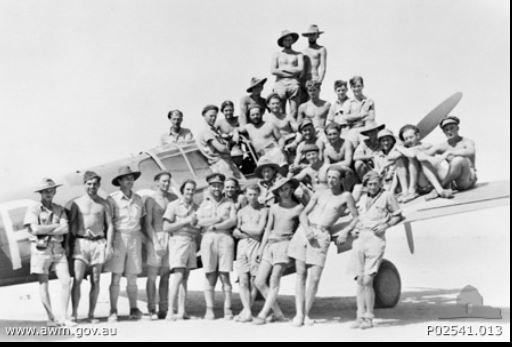No. 3 Squadron RAAF
From Our Contribution
|
. Ground crew in front of a P40 in 1942 AWM photo P02541.013 | |
Contents
Brief History
Originally formed during ww1 on 16 Jul 1916 as No. 2 Squadron, its nomenclature was altered on 25 Oct 1916 to No. 3 Squadron Australian Flying Corps at Point Cook. The Squadron sailed for England, arriving there on 28 Dec 1916. Following limited training they were set to Cambrai in France, and commenced active service in September 1917, remaining active until the Armistice in November 1918. After the Armistice the Squadron remained on the Continent and was used to transport mail for the Australian Imperial Force. In March 1919 it returned to England where it was stationed for a short period before embarking for Australia and disbandment in June 1919.
On 20 September 1939 the Australian Government approved the dispatch of an Australian air expeditionary force for overseas before the end or the year. On 28 Feb 1940 the Government decided that the 6th Australian Divison, AIF should have an Army Co-Operation Squadron. On 15 jul 1940, 21 offlccrs and 271 airmen sailed from Sydney on the RMS Orontes They transhipped to HMT Diwarra at Bombay on 7 August and arrived at Port Tewfik (Suez), Egypt, on 23 Aug 1940, becoming the first Australian Air Force unit to reach the Middle East in World War II.
On 16 Sep 1940 the Squadron was ordered to Helwan, near Cairo, to be reconstituted on a three-flight basis-two of Gladiators and one of Lysanders-plus four Gauntlet aircraft which were to be used to train aircrew in dive bombing tactics. In November, two flights of 3 Squadron to commenced operations against tlu~ Italian forces while the Lysnnder flight moved to lkingi Maryout (near Alexandria). On 19 Nov 1940, 3 Squadron recorded its first combat mission in World War II when four Gladiator aircrilft were attacked by no less than 18 Italian CR-42 aucraft. From this encounter the pilots clrumed six enemy aircraft but, for the loss of its first casualty.
With the commencement of the first desert campatgn on 8 Dec 1940, 3 Squadron gave the Army air support with its aircraft flying offensive patrols over the Western Desert in Egypt and Italian Cyrenaica. In late January 1941 the Squadron began to be re-equipped with Hurricane aircraft, and with the end of the first desert campaign the Squadron relocated to Benina, near Benghazi, the capital of Italian Cyrenaica. It arrived on 10 Feb 1941 and in April Rommel's Africa Korps commenced the first of many offensives and the Allied forces retreated from Cyrenaica.
The Squadron was then sent to Palestine where, at Lydda (now Ben Gurian lntemational Airport), it was re-equipped with American Tomahawk aircraft. When the 7th Australian Division advanced against the Vichy French in Syria, 3 Squadron joined forces with it and commenced operations in this campaign by attacking Rayak satelite airfield on 8 Jun 1941. The Allies forced the Vichy French capitulation on 12 Jul 1941. At this stage the Squadron was stationed at Rosh Pinna in Northern Palestine. The Squadron moved to Rayak and, on 3 Sep 1941, left Syria and moved back into Egypt where it commenced offensive patrols from Sidi Haenish. During the early days of the second Allied offensive, Kittyhawk aircraft began to arrive and the Squadron commenced operations as a fighter bomber unit, a role it carried out until the end of the War.
The Afrika Korps began a fresh push towards Egypt and in February, 3 Squadron was back at Gambut, half way between Tobruk and Bardia. During March the unit was withdrawn from operations, but within a month It was back in action. A heavy German bombing attack took place on 25 May as the Axis forces started their final offensive, which they hoped would take them nght through to the Suez Canal. 3 Squadron fell back to Amiriya, near Alexandria, flying many sorties every day. With the Army holding the line at El Alamein, the Squadron flew daily in support of medium bombers and during this period performed a fighter role until the Allied forces, commenced an offensive on 23 Nov 1942 with the Squadron at the start of a long hard campaign, finally arriving in Tunisia on 18 Apr 1943, remaining there until 9 May, when the AXIS forces surrendered.
The invasion of Sicily occurred soon after and on 16 Jul 1943 the advance parties of 3 Squadron landed at Pochino, in Sicily. ln September the ground staff began to move into Italy-firstly to Crottaglie, then Bari on the Adriatic and, soon after, to Foggia. In October another move, this time to Meline where the Squadron experienced its first taste or an Italian winter. On 1 Jan1944 the Squadron moved to Cutella, where ot spent five miserable months in an extremely cold winter. The next move was in May, to San Angelo, where the Squadron took part in the famous Cassino campaign. On 14 June it went to Guidonia, an airport near Rome. The Squadron moved to Falarium on 23 June, then to a landing ground named Crete on 9 July. On 24 Aug 1944 the Squadron shifted to Jesi on the Adriatic where it was re-equipped for the last time during the War, with Mustang a1rcra!t modified to carry two !OOOlb bombs. Then it was north again, to Fano, arriving in November 1944 and staying there until the end of February 1945, when it shifted to Cervoa. It was at this stage the European war ended.
Battle Honours
Individual Honours
Ground Crew
- Warwick Geoff Samuel Savage 9 Sep 1941 - 1 Mar 1943
Notes
